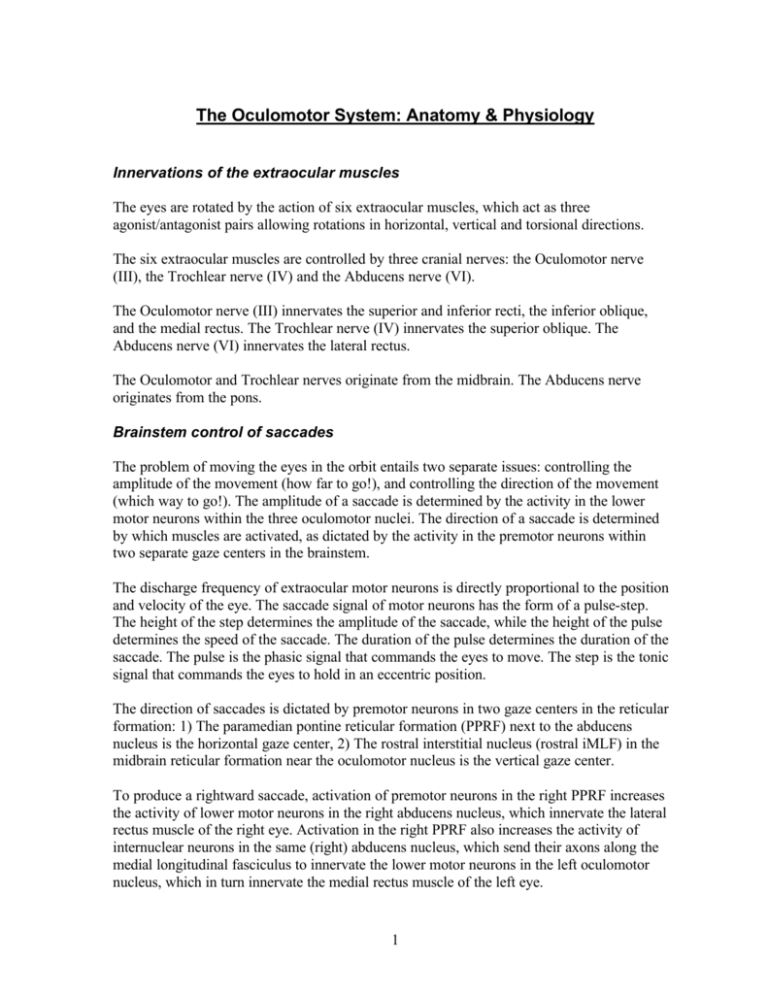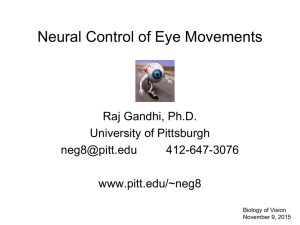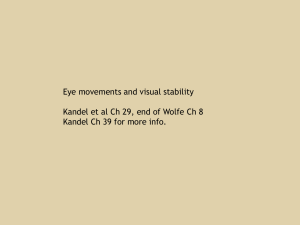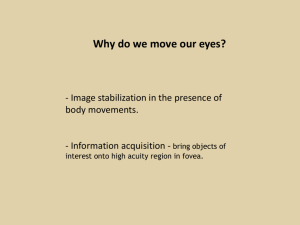The Oculomotor System: Anatomy & Physiology
advertisement

The Oculomotor System: Anatomy & Physiology Innervations of the extraocular muscles The eyes are rotated by the action of six extraocular muscles, which act as three agonist/antagonist pairs allowing rotations in horizontal, vertical and torsional directions. The six extraocular muscles are controlled by three cranial nerves: the Oculomotor nerve (III), the Trochlear nerve (IV) and the Abducens nerve (VI). The Oculomotor nerve (III) innervates the superior and inferior recti, the inferior oblique, and the medial rectus. The Trochlear nerve (IV) innervates the superior oblique. The Abducens nerve (VI) innervates the lateral rectus. The Oculomotor and Trochlear nerves originate from the midbrain. The Abducens nerve originates from the pons. Brainstem control of saccades The problem of moving the eyes in the orbit entails two separate issues: controlling the amplitude of the movement (how far to go!), and controlling the direction of the movement (which way to go!). The amplitude of a saccade is determined by the activity in the lower motor neurons within the three oculomotor nuclei. The direction of a saccade is determined by which muscles are activated, as dictated by the activity in the premotor neurons within two separate gaze centers in the brainstem. The discharge frequency of extraocular motor neurons is directly proportional to the position and velocity of the eye. The saccade signal of motor neurons has the form of a pulse-step. The height of the step determines the amplitude of the saccade, while the height of the pulse determines the speed of the saccade. The duration of the pulse determines the duration of the saccade. The pulse is the phasic signal that commands the eyes to move. The step is the tonic signal that commands the eyes to hold in an eccentric position. The direction of saccades is dictated by premotor neurons in two gaze centers in the reticular formation: 1) The paramedian pontine reticular formation (PPRF) next to the abducens nucleus is the horizontal gaze center, 2) The rostral interstitial nucleus (rostral iMLF) in the midbrain reticular formation near the oculomotor nucleus is the vertical gaze center. To produce a rightward saccade, activation of premotor neurons in the right PPRF increases the activity of lower motor neurons in the right abducens nucleus, which innervate the lateral rectus muscle of the right eye. Activation in the right PPRF also increases the activity of internuclear neurons in the same (right) abducens nucleus, which send their axons along the medial longitudinal fasciculus to innervate the lower motor neurons in the left oculomotor nucleus, which in turn innervate the medial rectus muscle of the left eye. 1 Excitatory burst neurons in the PPRF provide the phasic signal of the abducens motor neurons. Tonic neurons in the nucleus prepositus hypoglossi integrate the PPRF’s phasic signal to provide the tonic signal of the abducens motor neurons. Inhibitory burst neurons in the PPRF silence the contra-lateral abducens interneurons and motor neurons to relax the antagonist muscles. Omnipause neurons inhibit the burst neurons in the PPRF, thereby preventing saccades. A trigger command silencing these neurons is necessary to activate the saccade burst generator. Superior colliculus control of saccades The Superior Colliculus provides both the motor command to the PPRF’s burst neurons and the trigger command to the omnipause neurons. It is a laminated structure situated on the roof of the midbrain. It sends projections to both the horizontal (PPRF) and vertical gaze centers (rostral iMLF), providing the motor command to move the eye to an intended new position for the foveation of a visual stimulus. The superior colliculus contains a topographic motor map composed of neurons that discharge a high frequency burst of action potentials immediately prior to saccades that have a specific vector, i.e., a direction and amplitude that is independent of the initial position of the eyes in the orbit. The integrity of the superior colliculus is crucial for the production of short-latency reflexive saccades, including the “express” saccades whose latency approach the fastest time for visual signals to reach the oculomotor system and trigger a saccade. Lesions of the superior colliculus permanently abolish the production of express saccades. Higher saccadic control centers The saccade-related activity of the superior colliculus neurons is shaped by inputs from the posterior parietal cortex, the frontal eye fields, and the substantia nigra pars reticulata. The posterior parietal cortex is involved in the visual guidance of saccades by shaping the visual inputs to the superior colliculus. The posterior parietal cortex contains neurons that are modulated by visual attention, i.e., by how behaviorally relevant a visual stimulus is. They respond more effectively when the stimulus is the target for an eye movement. The frontal eye fields form an executive center that can selectively activate superior colliculus neurons, playing a role in the selection and production of voluntary saccades. The activity of frontal eye fields neurons reflects the selection of the visual target for a saccadic eye movement when several potential goals for movements are available. The frontal eye fields is also involved in suppressing reflexive saccades and generating voluntary, non-visual saccades. The complementary executive control exerted on saccade generation by the frontal eye fields and the superior colliculus is revealed by the effect of selective and combined ablation. 2 Lesions of the superior colliculus prevent the generation short-latency reflexive saccades, whereas the generation of voluntary saccades is disrupted by frontal eye fields lesions. Although saccades can still be produced after the ablation of either the superior colliculus or the frontal eye fields, a combined ablation of these two structures results in t he complete abolition of saccadic eye movements. The substantia nigra pars reticulata funnels inputs from the frontal cortex and act as a gate for the voluntary control of saccades, keeping in check the superior colliculus activity. The neural activity in the substantia nigra maintains the superior colliculus tonically inhibited to prevent unwanted saccades. Prior to a voluntary saccade, this tonic inhibition is reduced by inputs from the caudate, which is activated by signals form the cortex. Control of smooth pursuit eye movements Smooth pursuit eye movements are also mediated by neurons in the PPRF, but are under the influence of motor control centers other that those controlling saccadic eye movements. Motion sensitive neurons in extrastriate areas of the dorsal visual stream - middle temporal (MT) and medial superior temporal (MST) areas – are essential for the initiation and accurate guidance of smooth pursuit. These neuronal signals are transmitted either directly to the dorsolateral pontine nucleus or indirectly via the frontal pursuit region within the frontal eye fields before reaching the cerebellum, which provide the final processing of the motor command executed by both the vestibular nucleus and the PPRF. Control of the vestibulo-ocular reflex The horizontal VOR is a short tri-synaptic reflex with synapses at 1) the vestibular nucleus, 2) the abducens motor neurons, and 3) the lateral rectus muscle. Like the saccadic circuit, the VOR phasic command to the motor neurons comes directly from the vestibular nucleus while the tonic command is provided by an indirect projection through the nucleus prepositus hypoglossi. 3 4 Medial rectus Lateral rectus Oculomotor nerve Abducens nerve Oculomotor nucleus Medial rectus motor neurons Medial longitudinal fasciculus Excitatory burst neuron Omnipause neuron Paramedian pontine reticular formation Interneuron Motor neuron Inhibitory burst neuron Nucleus prepositus hypoglossi Tonic neuron 5 Abducens nucleus 6










